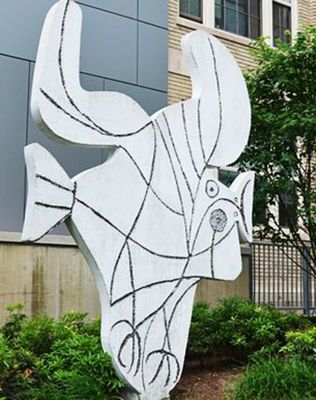
Description
Pablo Picasso, best known for his paintings and drawings, also applied his restless energies to sculpture. His earliest known sculpture, modeled in clay to be cast in bronze, was made in 1901; he subsequently produced over six hundred throughout his life. Picasso worked generally in two sculptural modes, each grounded in their respective materials and techniques. He modeled sculpture in the round in clay or plaster for casting in bronze; he also constructed frontal, open-form works from cut or found pieces of sheet metal, metal rods, wood, or cardboard. During the 1950s and 1960s, he developed in the latter mode a series of sculptures that were cut from a single sheet of wood or metal and painted. The painted wood and metal cut-outs are closer to painting and drawing than are most of his sculptures and give new importance to painted surfaces in defining and articulating the represented forms. Picassos interest in combining painting and sculpture attracted him to ceramics, a medium in which he worked prodigiously during the 1950s and 1960s. MITs Figure dcoupe (Cut-Out Figure) is one of the cut-out sculptures conceived during the 1950s. It was originally executed in 1958 in oil on wood and represents a bird with head and beak to the right, tail to the left, feet below, and spread wings above. Figure dcoupe grew out of a series of pen and ink notebook drawings done on May 11, 1958, of birds in flight and owls, none of which, however, correspond in all features to the sculpture. In 1956 Picasso met the Norwegian artist Carl Nesjar who introduced him to a process of concrete casting called betongravure (concrete engraving). Betongravure was developed in Oslo by the architect Erling Viksj and the engineer Sverre Jystad. Nesjar adapted the process for the enlargement to monumental scale of Picassos planar sculpture. A wooden form that reproduces the outline shape of the original sculpture is built and filled first with an aggregate of dark gravel or crushed stones and then with poured concrete that binds and faces the aggregate. A template is made from the painted lines and areas of tone on the original wood or metal sculpture then the concrete surface is sandblasted through the template, exposing the color and grain of the aggregate underneath. This method permits furrows of varying depth and width to be cut and areas of tone and texture to be revealed. Picasso had long desired to make monumental sculptures; betongravure made available to him a technique suited to the translation of his recent planar sculptures into durable materials on a monumental scale. Picasso entrusted Nesjar with the enlargement and fabrication of his sculpture in concrete. Their collaboration was most productive during the 1960s. In 1963, the first of the concrete casts of Figure dcoupe was made. It was cast again in 1964 in the same size and in 1965 was further enlarged in another cast to 16 6 high. The second cast is in Halsingborg, Sweden; the third is in the Vondelpark in Amsterdam. MITs sculpture stands 116 high, and was cast and installed in May 1975.
Details
- Work Date:
- 1975
- Location:
- Room No. 1
- Dimensions:
- 138 in. x 96 in. x 5.5 in. (350.52 cm x 243.84 cm x 13.97 cm)
- Medium:
- Cast concrete with aggregate interior, engraved by sandblasting (“betongravure”)
- Credit Line:
- Purchased with funds made available through an anonymous gift to MIT